Tanzania Multi Stakeholder Map - WebNG
Tanzania Multi Stakeholder Map - WebNG
Tanzania Multi Stakeholder Map - WebNG
You also want an ePaper? Increase the reach of your titles
YUMPU automatically turns print PDFs into web optimized ePapers that Google loves.
PESTICIDES AND POVERTY<br />
WHAT IS ECOTOXICOLOGY?<br />
ECOTOXICOLOGY: MONITORING<br />
THE IMPACT OF PESTICIDES<br />
Yahya Msangi / Silvani Mng’anya<br />
August 2005<br />
• Relatively a new discipline<br />
• Combines 3 disciplines: chemistry, toxicology,<br />
ecology<br />
• The science is not yet sufficiently developed to<br />
allow accurate predictions but methodological<br />
frameworks & databases are available and these<br />
can assist in risk assessment<br />
• Risk assessment is a TOOL that provide useful<br />
assistance in decision making<br />
• Involves a team of people & range of equipment<br />
1<br />
2<br />
RISK ASSESSMENT<br />
• Predictive exercise about a change or an<br />
intervention (such as pesticide use) that is based on<br />
scientific data, judgements and assumptions<br />
• Identifies significant hazard and estimates the<br />
likelihood of harm to individuals or the environment<br />
• Enables decision to be made about ways to reduce<br />
or eliminate risk (risk management)<br />
• Determine objectively the least damaging and<br />
reasonable option<br />
• Balance of risk against benefit must be ascertained<br />
WHY MONITOR THE ECOLOGY?<br />
• The amount of pesticides that actually<br />
reaches the target is frequently small, much<br />
ends in the environment<br />
• The behaviour of pesticides and their<br />
environmental impact has mainly been<br />
studied in temperate climates, need for<br />
studies in tropical climates<br />
• As CSO / NGO we need ecotoxicological<br />
monitoring skills for the ASP<br />
3<br />
4<br />
DESIGNING AN ECOLOGICAL MONITORING PROGRAMME<br />
A. THE AIMS OF AN ECOLOGICAL MONITORING<br />
PROGRAMME ARE:<br />
• Assessing pesticide impacts<br />
• Selecting ecological processes or wildlife groups to<br />
monitor<br />
• Selecting appropriate sampling or monitoring<br />
methods<br />
• Processing and analysing the data collected<br />
• Interpreting the information<br />
DESIGNING AN ECOLOGICAL MONITORING PROGRAMME Cont’d<br />
B<br />
STAGES IN DEVELOPING AN ECOLOGICAL<br />
MONITORING PROGRAMME<br />
• PHASE I: PLANNING PHASE & RISK ASSESSMENT<br />
Desk Review<br />
Screening i.e. making hazards more explicit:<br />
? identification of the chemical i.e. the physicochemical<br />
& other properties of the pesticide and its<br />
formulation, including its water / oil solubility,<br />
persistence, and its tendency to bio-accumulate in<br />
soil, water, plant or animal tissue.<br />
5<br />
6<br />
146
















